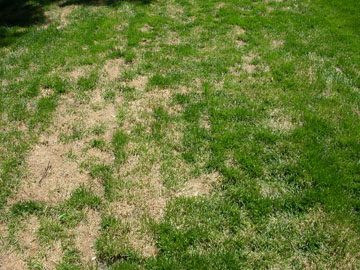A dormant lawn can be one of the more unsightly attractions for homeowners. Everyone wants their lawn to look healthy and vibrant. However when dealing with a dormant lawn, the grass is going to look brown and withered. This is a stark contrast to the green and lush appearance of a healthy lawn that every homeowner attempts to maintain. In many instances, lawn dormancy is caused by outside factors that are out of the lawn keeper’s control. Grass entering the dormancy phase essentially means that your lawn is going to sleep for an extended period of time.
Dormancy is a naturally occurring cycle that all types of grasses will employ, in an effort to conserve water and nutrients. Oftentimes this cycle will occur during the winter, but it can also happen during longer periods of drought in the warmer months as well. When a lawn goes dormant, one might think that there is no way of bringing it back to a healthy state. However, there are measures that can be taken to revive the dormant grass and return to its natural green appearance. Continue reading to learn more about our tips for recovering a dormant lawn.
Water deeply and infrequently. If you’re going to water your lawn, then deep, infrequent watering will go a long way to help lawns cope with dry conditions. Early morning watering (5 a.m. to 9 a.m.) is ideal. This ensures the grass gets the moisture it needs and reduces evaporation. Watering your lawn late in the day or a night causes fungus and disease to attack your lawn. A weakened lawn most certainly does not need more stress by keeping your lawn wet while it is dark.
Mow high. Set your mower height to three to four inches. Mowing high gives the lawn a deeper and larger root system, keeps moisture in, defends against weeds, and keeps the soil cooler. Mowing too short during dry conditions can injure or wear out dormant grasses to the point where they may not come back during cooler conditions. It will also further stress your lawn causing it to be more susceptible to fungus and disease damage. ∙
Remove grass carefully. Just as a reminder, never remove more than one-third of the grass at one time. It will cause too much stress on the grass.
Mulch instead of bagging. Mulch your lawn instead of bagging the clippings. Mulching keeps more moisture and nutrients in the soil.
Maintain your lawn equipment. Sharpen your lawn mower blades twice a year. A dull blade tears at the grass, forcing it to use 40–60% more water to recover.
If you can’t water regularly, let your lawn go dormant when the weather turns hot. Dormancy means active shoot growth will stop. Grasses may turn brown, and some may die, but the crown, rhizomes, and roots are still alive. During this time, you want to apply just enough water to keep the turf alive until conditions improve. The best recommendation when the lawn is in dormancy is to provide a ¼ to ½ inch of water every two to four weeks. Keep an eye on the weather conditions, because you do not want to bring the turf out of dormancy too early. Breaking dormancy early actually will drain reserves within the plant if conditions remain dry. Once it cools down or rain starts to fall, shoot growth will begin again, and the lawn will green up.
Maintaining a lawn during a drought takes a bit more care than usual. When you implement these tips, you will help keep the turf healthy during the worst periods of any extended dry spell. If you need further assistance with maintaining your lawn, reach out to a professional lawn care service. Blue Grass Lawn Service has been providing their lawn services to home and property owners in New Jersey and Pennsylvania for over 36 years.
